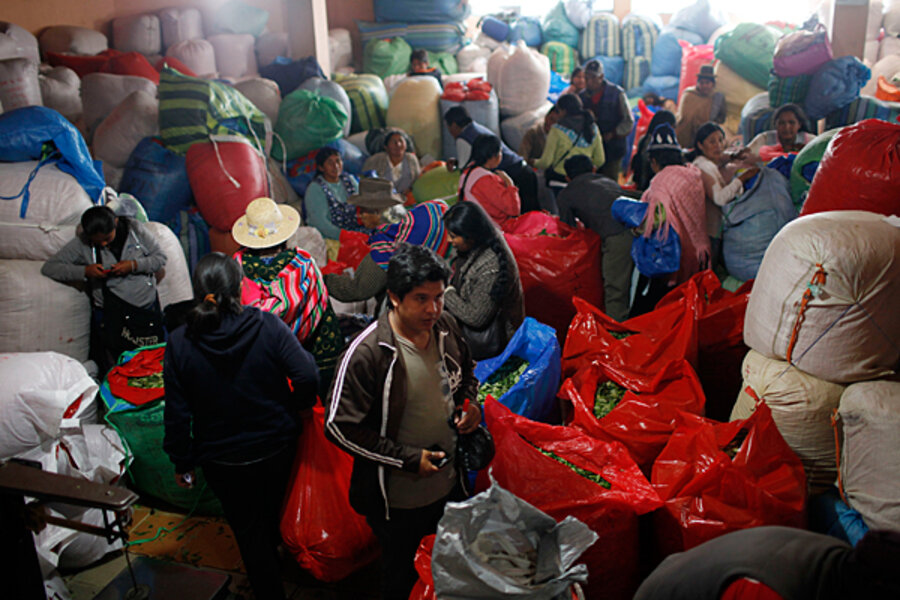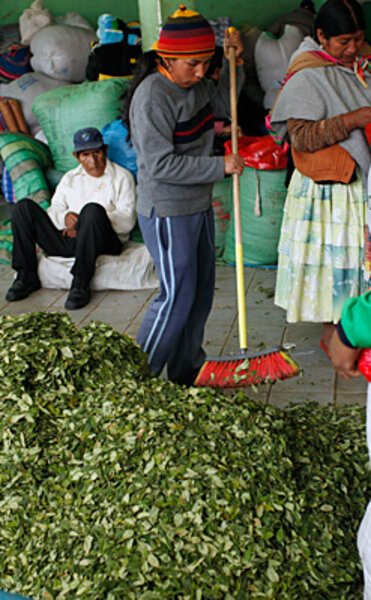Bolivia cuts coca cultivation: What about cocaine?
Loading...
| La Paz, Bolivia
Former coca farmer and Bolivian President Evo Morales often clashes with the United States over drug policy, and in 2008 ordered the United States Drug Enforcement Administration (DEA) out of Bolivia. At the center of the problem has been the coca leaf: It has long held religious and cultural significance for indigenous Andean peoples, but it is also the raw material used to produce cocaine.
Now, as Bolivia tries to balance respect for coca's traditional uses with the need to limit cultivation and cocaine production, two reports show significant decreases in coca crops between 2010 and 2011.
Cultivation of the coca leaf in Bolivia fell roughly 12 percent – from just under 120 square miles to 105 square miles – between 2010 and 2011, according to an annual report released by the United Nations Office on Drugs and Crime (UNODC) today. That's the first reduction Bolivia has seen since 2005.
The UN report comes close on the heels of a US Presidential Memorandum on Bolivia published last week in which the US found that Bolivia “failed demonstrably during the previous 12 months to adhere to their obligations under international counternarcotics agreements."
Because of that perceived failure, Bolivia was "decertified" by the US for the fifth consecutive year. Decertification can affect the flow of some kinds of US assistance, with the exception of anti-narcotic and humanitarian aid, but Bolivia received a waiver that allows aid from the US to continue, as did Myanmar and Venezuela, the two other countries decertified this year.
According to the memorandum, Bolivia's ability to combat drug trafficking declined markedly when it expelled the DEA, and the country should maintain better control of legal coca markets and execute a national drug control strategy. However, US data does report a decline in coca production, from 133 square miles in 2010 to 116 in 2011.
President Morales rejected the US decision to decertify the country, saying the US criticizes Bolivia for resisting its policies, and refuses to recognize its accomplishments in the fight against drugs for political reasons.
"The United States has no moral authority to speak on the fight against drug trafficking," Morales said, according to state news agency ABI. "The biggest market for cocaine and other drugs is the United States."
Though both the US and UN agree there was a reduction in Bolivian coca crops cultivated between 2010 and 2011, information published by the US Office of National Drug Control Policy estimates potential cocaine production in Bolivia actually increased by 36 percent from 195 to 265 metric tons.
The UN did not publish estimates on potential cocaine production this year, but said "[e]xtraction methods normally do not vary significantly from year to year. However, there is some indication that the efficiency of laboratories in Peru and Bolivia has gradually changed due to the influence of the Colombian production method." The Colombian method makes the cocaine production process faster and easier to hide by using tools like a weed cutter and chemicals to prepare the coca leaf, instead of placing it in large pits where the leaf used to be mashed by walking on it of hours.
The US estimates of cocaine production has inspired some skepticism among analysts, especially in light of recent US data on coca cultivation in Colombia. Colombia works in close partnership with the US on its drug policies. In recent years it was the world's top cocaine producer, but the July US report found Colombia's potential cocaine production had dropped below Bolivia's – despite US data that shows Colombia cultivates 320 square miles of coca to Bolivia's 116.
“Beginning in 2008, cocaine production in Bolivia increased due to the usage of more efficient cocaine production techniques that had been brought from Colombia,” according to the US Office of National Control Policy.
Some question that conclusion. “For Bolivia to be producing more cocaine than Colombia from half as much coca is difficult to fathom," The Washington Office on Latin America (WOLA) wrote in a paper following the release of the US data on Colombia. The methods of producing cocaine attributed to Colombia “are apparently not at work in Colombia,” WOLA wrote.
While Bolivia's recent success in cutting back on coca crops is a point of agreement for the UN and US, exactly what that means for cocaine production remains a topic of debate.








